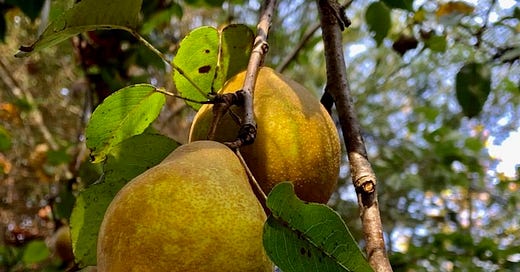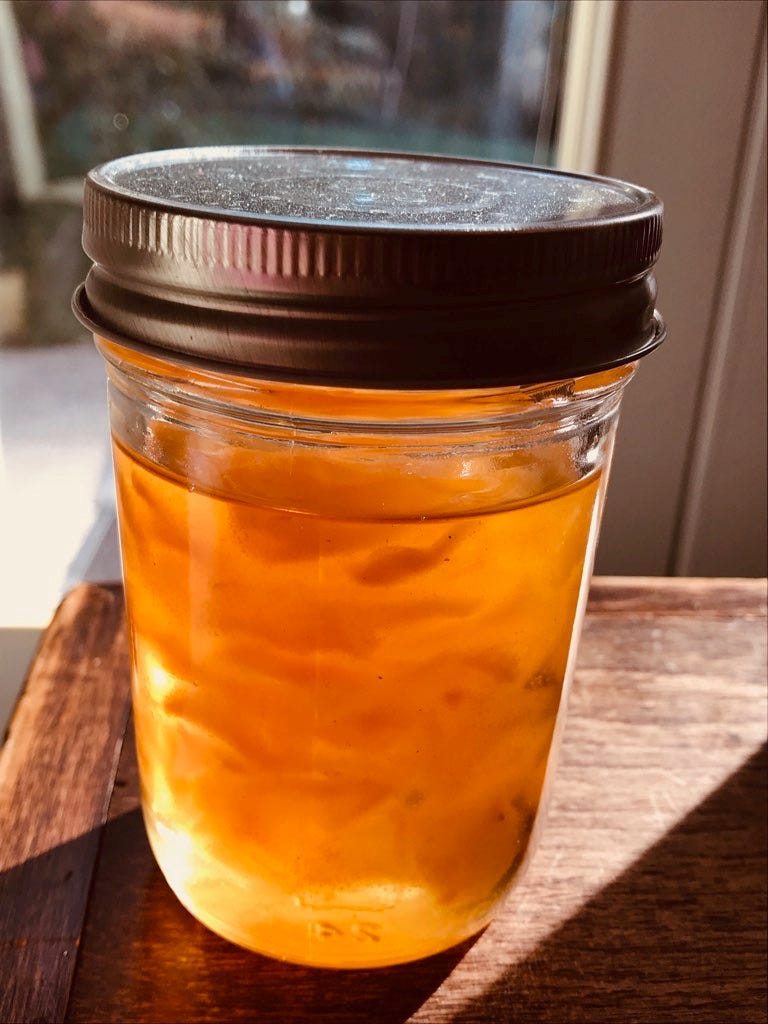The pear tree in my neighbor’s yard in the Blue Ridge Mountains is a holdover from the smattering of heirloom pear trees that still live on the fencerows of old homesteads in the Appalachians. Farmers often planted fruit trees as property line markers. My neighbor’s heirloom pear tree is almost certainly of European descent. There are no native pears in North America. They were introduced in 1629 as seeds from England. They were planted and evolved into many purely American strains. The knobby green and copper tinted pears that are hanging from great heights in profusion up the road are probably an old variety of pyris communis, the common pear, or what the oldtimers called “canning pears.”
Pyris communis Photos by Donna Campbell
In the thirty years that I have owned this log cabin in the Blue Ridge, my neighbor Mary, who lives most of the time in Clearwater, Florida, has never picked the hefty pears, leaving them to the enjoyment of the deer, bear, and squirrels. Donna Campbell and I decided to ask if we might pick a few. Mary texted back to say we could have all we wanted. Picking pears set us to talking about our childhood experiences of this ephemeral fruit and the seasonal ritual that they provided.
My Eubanks grandparents and both sets of Donna’s grandparents kept the trees to guarantee an annual stock of pear preserves. I loved to drizzle the sweet syrup from these golden jars over my morning toast at my grandmother’s kitchen table. Biting into the cubed pear pieces in the preserves was not my favorite part, but Donna says she most loved the crisp crunch of the fruit. Hearing of our windfall of pears, Donna's brother Eddie called to offer recipe suggestions for preserves which included cloves and allspice. He told Donna she probably could never match the taste of their grandmother’s preserves, which was a surefire way to get her to try. He now has a jar to sample.
As a young man, my grandfather tended an orchard for his livelihood before going to work for the postal service. When he and my grandmother bought five acres and eventually retired on the outskirts of Atlanta, he planted his own stand of peaches, blue and white plums, and a single pear tree. When I was six, he died, and the pear was the only one of his fruit trees that my grandmother spared from the chain saw. She was not up to the pruning and spraying required. She did leave the native crabapples up near the road for herself and her birds, but fussed every year about the autumn litter that her lawn mower would chop and throw across the otherwise pristine lawn. Her only reward was a few precious jars of pale pink jelly made from the hard little knobs that she could reach or shake loose from their limbs.
I remember how, in contrast to my rural grandmother’s love for a jar of crunchy pear preserves, my mother’s citified generation craved a pear salad. For our supper and for guests, she’d spoon out commercially canned pear halves side by side, perfect in their symmetry on a leaf of iceberg lettuce, then add a creamy white dollop of mayonnaise topped with half a maraschino cherry. Welcome to bridge club.
Meanwhile, we children carried fruit cocktail in our Roy Rogers lunch boxes. Cubes of pear and peach mingled with skinless white grapes like eyeballs, interrupted only by an unnaturally bright cherry or two for color. I always ate the peaches first. The pale pears in that cloying syrup were a little grainy—a small but perhaps significant impairment to my overall appreciation of pears.
These instant pears in cans did not hold the same magic power of recipe and ritual that our grandparents preferred.
It was much later that I came to love eating fresh pears when a number of seasonal varieties—mostly grown in the Northwest--began appearing at specialty groceries, usually for a high price. The best varieties, because of their fragility in shipment and brief period of ripeness, tend to be expensive—think Harry & David’s.
The well-known Comice pears of Harry & David’s, a company founded in 1910, were always a luscious gift to receive at the holidays from family friends. But the demand of delivering perfectly ripened fruit in increasing quantities on a mail order deadline seems to have gotten tougher over the years. After changing hands and diversifying its product line many times over, that stalwart company declared bankruptcy in 2012 and is now owned now by 1-800-Flowers, Inc. Harry & David’s closed all of its retail stores in April of this year as part of its continuing turnaround effort. Not a good sign.
Ralph Waldo Emerson said, “There are only ten minutes in the life of a pear when it is perfect to eat.” Jim Harb, my cooking consultant and friend in Knoxville, disagrees. “The window is even shorter,” he told me on the phone and laughed with mischief.
According to the online magazine Zerxza:
As opposed to apples, which ripen on the trees, pears need an additional 30 to 60 days after being picked before they’re ready to be eaten. Needless to say, the apple is a much easier fruit to harvest, store, transport, and sell. And since consumers purchase more apples than pears, that’s where so much of the research funding continues to go.
The same is apparently true of the marketing resources devoted to pears in this country, though I suspect that the huge 30- to 60-day window for ripeness is quite variable according to the variety of pear.
Pear pickers Susan Campbell, Georgann Eubanks, Dennis Williams, and Alvis Smith
The loaded pear tree at my neighbor’s house bears out the delay in ripening, however. Some of the knobby green pears with their short necks are huge and have remained hard as baseballs for a couple of weeks already—posing a hazard worthy of a helmet as we stand under the tree to pick them. Our friend Karen Wells, who grew up eating pear preserves in Jackson, Mississippi, told us to take heart. These hanging rocks could be managed. To make preserves, Karen explained, the pears must be peeled, weighed, cut up, and subjected to an 18-hour sleepover in a pot with an equal amount of sugar to draw out their juices. Then they could be cooked down for preserves. Neither Donna nor I had paid enough attention to our grandmothers’ rituals to know about this overnight soaking.
In a luxurious, pandemic-induced cooking spree, Donna has thus now made two batches of pear preserves, a fabulous pear chutney with cloves and mustard seeds, elegant peeled pears poached in wine, and a pear clafoutis--which is a rich, French fruit tart made from a blended batter of sugar, eggs, vanilla, salt and flour.
Donna’s clafoutis made with pears
Last fall at Half-Mile Farm in Highlands, North Carolina, Donna and I had a clafoutis for the first time at breakfast. We were there as special guests of the luxury country inn where the owners were kind enough to offer us a chance to present the book, The Month of Their Ripening: North Carolina Heritage Foods Though the Year, to other weekend visitors at an afternoon reception and book signing. We were joined by Carol Misner, the botanical illustrator for the book, who makes her home in Highlands.
Strewn with fruit throughout, the eggy clafoutis (the “s” is silent in French) cooks up puffy and custard-like in a tart pan or casserole dish. We agreed that the dish works equally well for breakfast or for dessert. While clafoutis is apparently most often made with stone fruits such as cherries or apricots and other tender fruits such as figs, our rock hard pears submitted to the task without the need for a soak in sugar.
As the reliable Oxford Companion to Food suggests, “the flavour of cooked pears is often improved by the addition of, e.g. red wine, almonds, or vanilla. Pears also go well with chocolate.” The authors note that Italians eat pears with parmesan or pecorino cheese—another idea for later this week as the pears keep coming.
A few nights ago, Donna served warm poached pears in a red wine reduction with sugar and cinnamon alongside a scoop of Celebrity Dairy’s incredible “Confetti” ice cream, made from their Chatham County goat’s milk, flavored with vanilla and cracked black peppercorns. It was a stunning combination.
On the night of the clafouti, our neighbors and dinner guests Alvis Smith and Dennis Williams surprised us with a pear tart that Alvis had made, and lo and behold, it was flavored with brandy, lemon, and topped with toasted almonds—a totally different treatment, which we served up side by side with the clafoutis and with the last dabs of Confetti ice cream from the freezer.
In this period of confinement and extra care for community health, we have been fortunate enough to be able to take time to reflect on traditions past—how the ripening of pears once created the urge to preserve for a hard winter coming. Such cooking rituals may no longer be necessary for the pantry, but they enrich the season if we make time for them and honor those who came before us.








